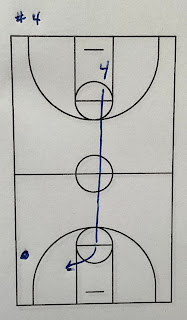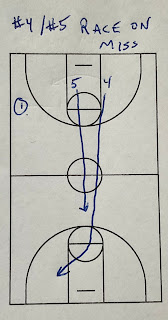Basketball minds can debate the best way to teach a fastbreak system, and debate what the best system to run as a fastbreak. Today there are coaches who are successful instructing the rebounder to push the ball and don’t outlet the rebound. Others are more traditional and have the team outlet the ball to any guard on the wing, then fill the lane on the side you are. There are many different ways to fastbreak.
At Galesburg, we started running what is called a “numbered fastbreak” in the Summer of 1985, and we stuck with it thru my retirement in 2024. For our program, the numbered break was center to everything we did offensively. What made me put in the “numbered break” to start with?
You would like to think some big or critical decisions are decisions that you debate and discuss at length. You would like to think that changing your fastbreak system must have taken staff meetings and examination of the pros and cons.
The first day of camp, we had done some warmup, some shooting, and were getting ready to do some fastbreak work. I had no intent to put the “numbered break” in, but said something about it. Jas said, “It’s summer, why don’t we try it?” So we with about a 20 second conversation decided to become a “numbered break” team.
The “numbered break” is a system where each player has an assigned number, and when your team gets a rebound each player has an assigned lane to run. #1 gets the outlet, #2 runs the right side, #3 runs the left side, #4 sprints down the middle and goes to ball side block.
 |
| Watson, Pendry, Wood |
People always say, “What if the #2 is on the left side?” The answer is they go run the right lane. Yes, there are times when players have to run farther to get to their assignment, but the theory is that by taking decisions out of the equation and making it automatic each possession- players will be faster getting down the floor.
Others would point out that the numbered break is too regimented, it takes decision-making out of things. And it makes you predictable, everyone knows where you are going. Both those points are absolutely true, but I would counter by saying that we take away the decision-making, we are faster. And while the opponent knows where we are going- because we do it every day, we will beat you there every time.
 |
| Watson passes to #2 before press can trap |
In the late ‘80’s I had an opportunity to listen to Paul Westhead of Loyola Marymount at a clinic. This was the era when they were scoring 120 points with regularity. Westhead was a ‘numbered break’ guy. He took things to a different level, he wanted to run on misses and on makes. It made sense so we started working on having our #5 get the ball out of bounds as fast as they could and inbounding the ball to the #1. (In Westhead’s numbering the #5 post is the trailer.) The premise of the system is that we would beat the other team in the first 2 seconds of a change of possession. Whether a made basket or miss and a rebound, each of our players knew exactly what to do. And they were drilled to start sprinting in the first 20 feet. By starting immediately and by going in a sprint- usually we had 3 players to half-court by the time the other team had one defender to half-court.
We had several teams who were good running the numbered break in the late ‘80’s and early ‘90’s. Our 1995-6 team was built for the numbered break, and they were great running the numbered break.
#2= Ami Pendry- she was the fastest player on the team and maybe one of the fastest players we ever had. She got wide in the lane and sprinted. Often she would be behind the defense and get a layup.
#3= Sara Wood- she had the ability to play any of the perimeter positions. Running the left side, she was great with her left hand and could catch, drive left and have a layup.
 |
| Bulkeley as #4, scores in post Over small guard. |
#4= Jen Bulkeley & Angie Galyean- they were both unrelenting and ran the break all of the time. The #1 to #4 pass for a layup was not unusual. Bulkeley was listed as taller but probably was only 5’9” and Galyean probably 5’8”. They consistently beat the opposing posts down the floor. So often if they got the ball in the post at the end of the break, they were being guarded by the opponents small guards who sprinted back.
#5= Jessica Thompson & Sarah Larson- They because masters of getting ball inbounded after made shots.
Through the years, we had other teams and other players who executed parts of the numbers break extremely well and extremely effectively. For example, Jenna Bicego and Latoya Wright were very good at the pass ahead to the #4. And Jessica Howard as a #2 mastered the “cheating and leaving early” to get open for a three.
No team ran the numbered break as well as the 1996 team. We always had five players on the floor who were masters of the break. We had three athletic guards who could run all day, could pass, and could shoot. And we had four post players who rotated in so we always had a post who took it out quick, and a post who won the sprint to the other end. That is why they averaged 70 points per game.
The coach from the Freeport coach after we upset them in the 1996 Sectional, sums up the numbered break best, “Galesburg doesn’t really care if you score, they just want to get the ball back and score as fast as they can.”
Sunday the Streak Scrapbook will look at the 1996 Girls Third Place in State Team.
Diagrams of the Numbered Break
#1 sprinted to side of the rebound for an outlet and got their back to the sideline.











No comments:
Post a Comment